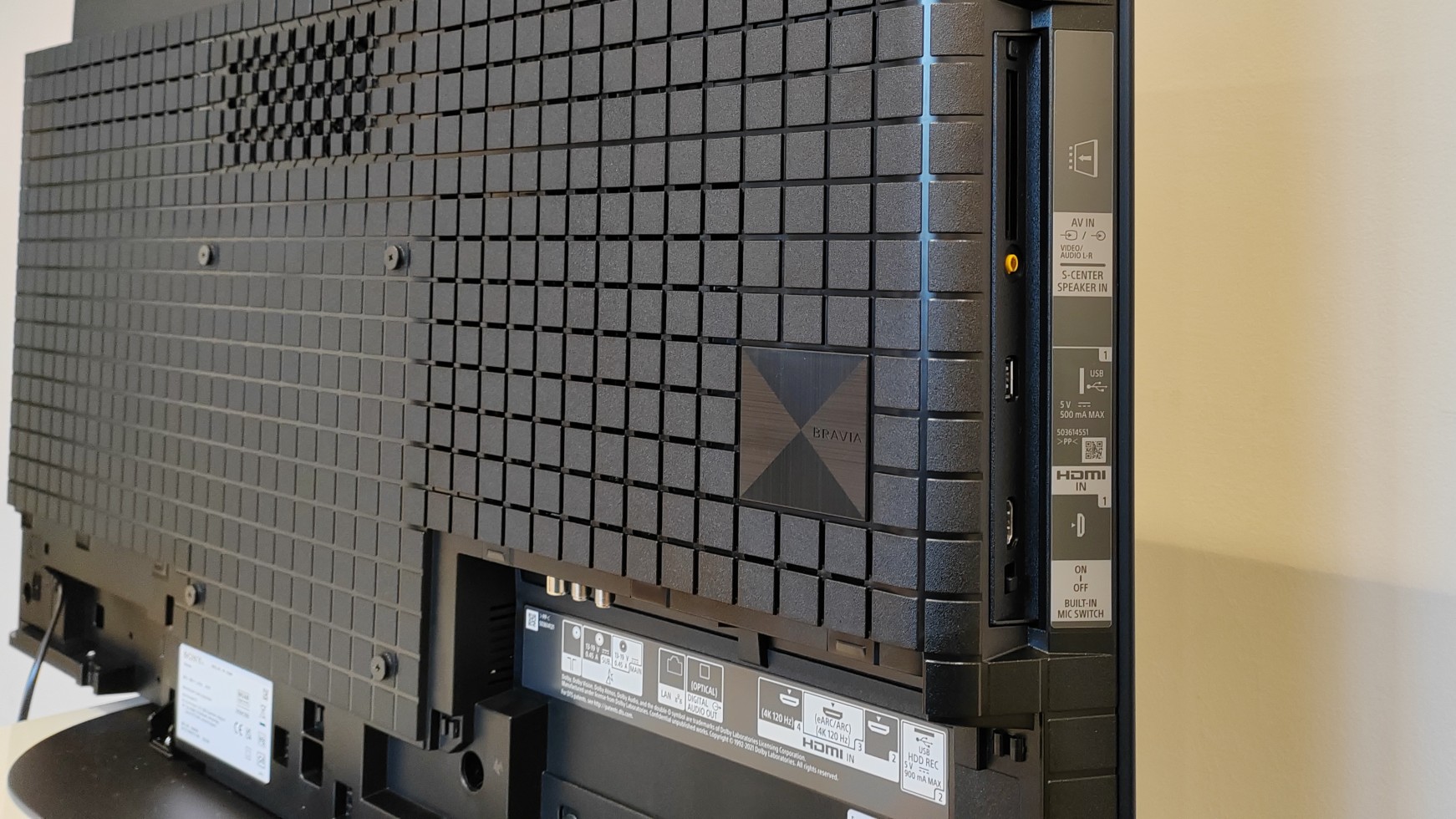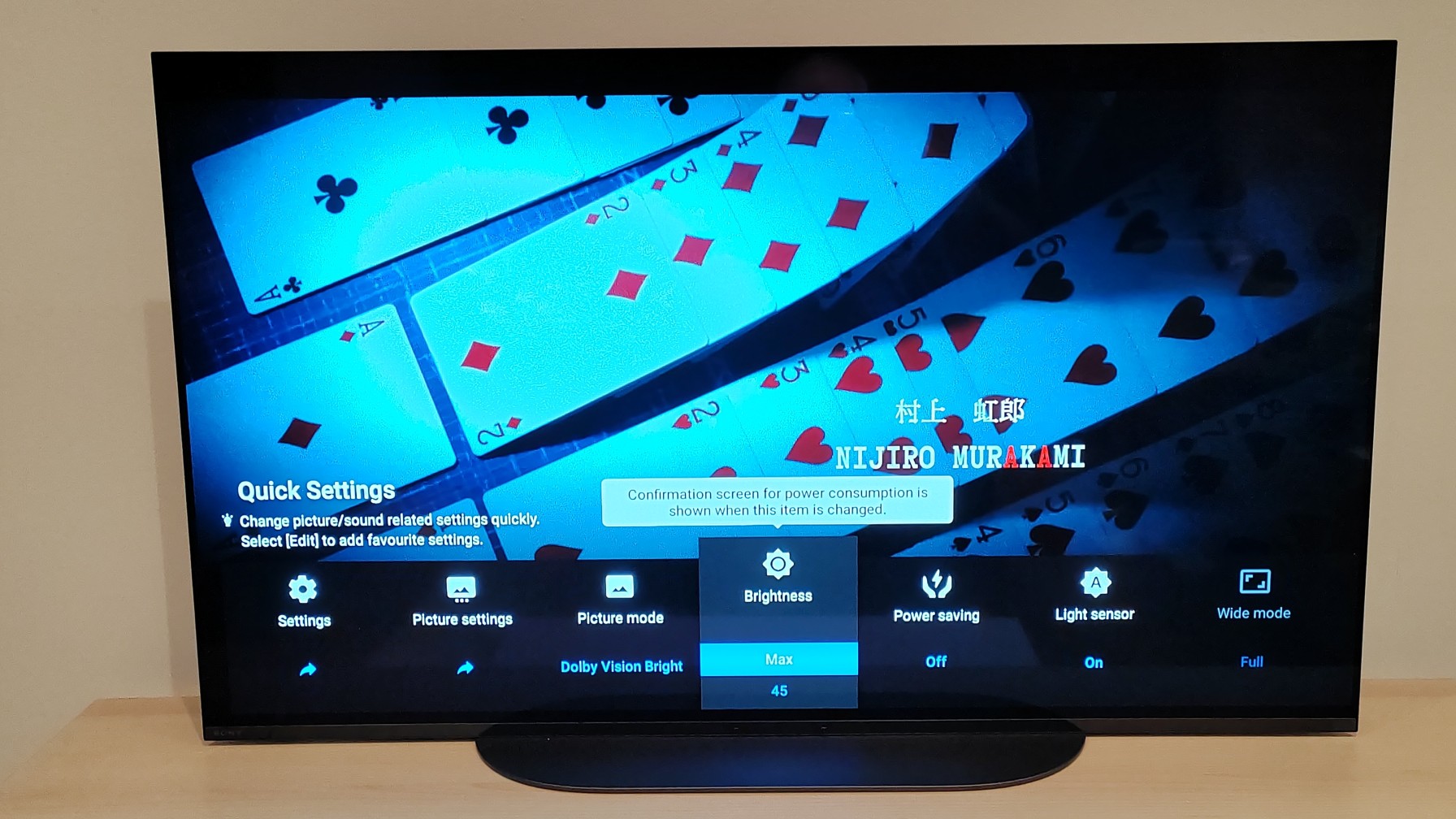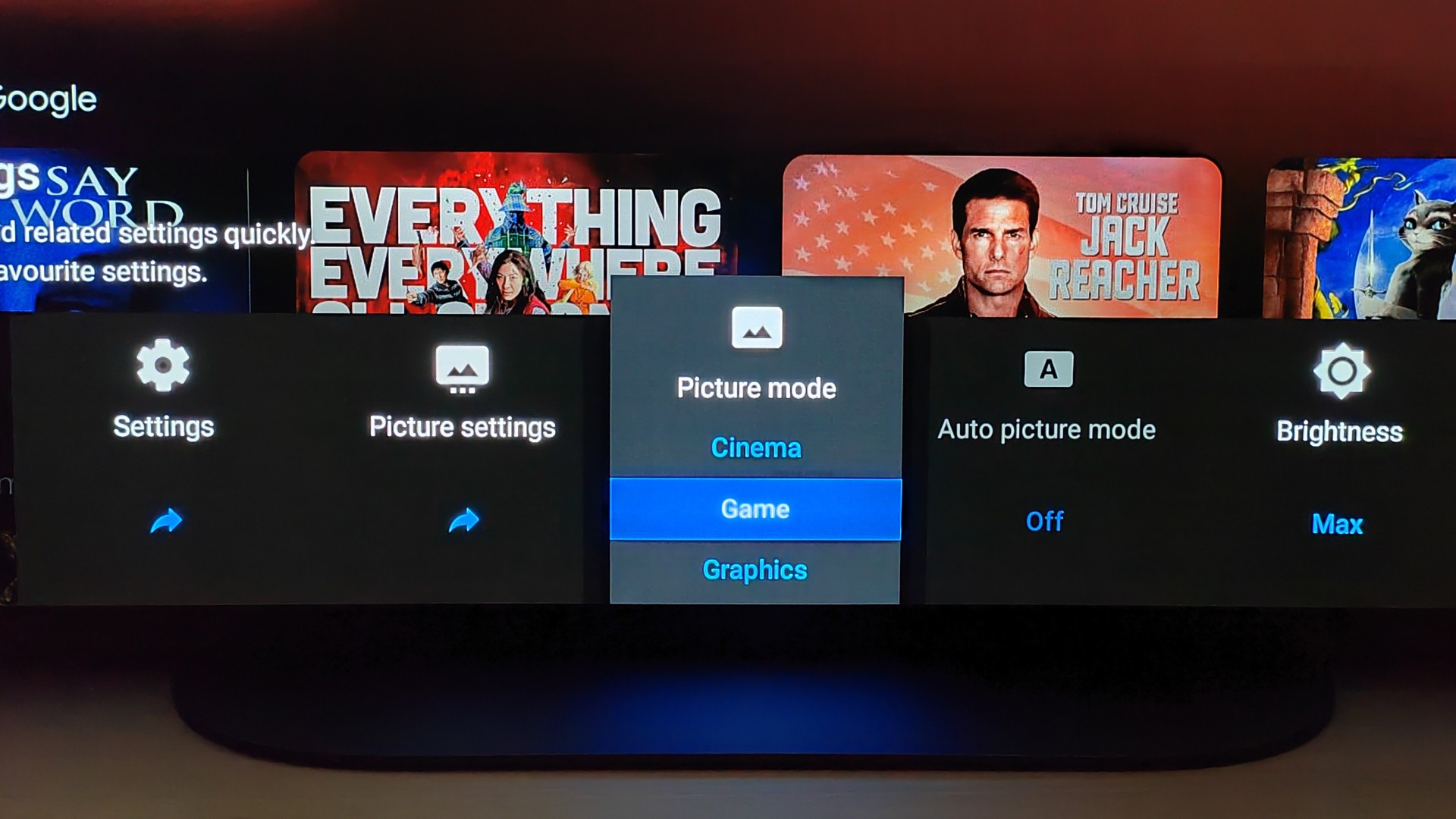GamesRadar+ Verdict
The Sony A90K is a high-performance small-screen OLED that's a brilliant option for gamers and smaller living rooms. Its HDR, 4K 120Hz, and picture performance are all excellent, though there are minor quibbles with its audio offerings.
Pros
- +
Nuanced, dynamic picture quality
- +
4k 120HZ support
Cons
- -
Only two HDMIs v2.1
- -
Expensive compared to competitors
- -
Audio sounds thin
Why you can trust GamesRadar+
Clearly courting high-end gamers, the A90K is a small (ish) 4K OLED model that works brilliantly as a gaming TV, every day 4K TV, and even a near-field gaming monitor. The set on our test bench is a 42-incher, but a 48-inch version of the A90K is also available.
And while it may be titchy, the A90K is a Tardis when it comes to technology. A direct challenger to the popular LG C2 OLED range, the A90K utilises Sony’s Cognitive Processor XR, and is able to prioritise those elements of an image the human eye naturally focuses on. It also features Acoustic Surface Audio+, which uses panel-vibrating actuators behind the screen for crisp audio, and runs the latest Google TV smart platform.
Has the time come to think small when it comes to upgrading your TV?
Features & Design
Compact but not lightweight, the A90K tips the scales at 29.3lb/13.3kg, and measures 2.2"/5.7cm from glass to heavily patterned back panel.
The screen sits on a lozenge-shaped 2-way aluminum pedestal, which makes the set’s overall footprint 8.9"/22.5cm deep. This is significant if you’re planning to use it as a large monitor in your gaming setup.
There are four HDMI inputs, of which two (HDMI 3 and 4) are v2.1 enabled and capable of 4K 120fps playback - putting it in line to be a superb small-scale candidate for our best 120Hz 4K TV guide. These inputs also support VRR (Variable Refresh rate) and ALLM (Auto Low Latency Mode). There’s eARC on HDMI 3, too, though, which limits your 4K 120fps options a little frustratingly. Another minor niggle is that there’s also no support for the HGiG standard.
If you’re planning to employ a gaming soundbar or gaming sound system with the screen, or use it as a gaming display and need to raise it to meet your eye line, there are two extenders in the box that lift the panel up from where it would normally sit flush to the pedestal.
Other connections include two USBs, a digital optical audio output, and Ethernet to support the wireless Bluetooth and Wi-Fi connections. The Bluetooth connection can be used to pair compatible Sony wireless headphones, including its WH-1000XMx over-ears and WF-1000XMx in-ears.

The screen has both terrestrial and satellite tuners. In the UK terrestrial catch-up is covered by YouView, rather than Freeview Play, but all the mainstream on-demand services are available.
The A90K ships with two remote controls: a standard IR zapper and a simplified, premium wand with backlighting. Only the premium remote comes with shortcut buttons for Netflix, Disney+, Prime Video, and Bravia Core - Sony’s own Bravia-specific high-bitrate movie streaming service.
The A90K is built around the Google TV smart interface. Consider this a more streamlined variation of the more familiar Android platform, albeit with equally broad streaming app support. You’ll find all the good stuff here, including AppleTV+, Disney+, and Prime Video. The A90K has Chromecast built-in, along with Apple AirPlay and Homekit compatibility too. There’s a microphone built-in for voice interaction, but if that’s not your thing, it can be disabled with a physical switch.
Setup is governed by the Google Home app. Follow the prompts and it’ll pair with the TV, sign the set into your Google account and sync any apps required. You can then use the app to tune channels, and partner any connected gizmos, be they consoles, media sticks or set-top boxes.

Performance
We love the picture quality of the A90K. This diminutive display punches well above its weight in terms of depth and detail. Images are blisteringly sharp, yet naturalistic, with richly saturated colours. The wide gamut XR Triluminos Pro panel does a superb job depicting bright primaries.
Much of the screen’s clarity and subjective depth is down to that clever Cognitive processor. Designed to mimic how our eyes naturally focus, the processor divides the screen into various zones and then detects where the correct ‘focal point’ is in the picture. Thanks to oodles of processing muscle, it can cross-analyse an array of elements at once, adjusting each in synchronisation. The pixel density of this smaller screen also aids when it comes to upscaling: sub 4K sources still have clarity and pop.
Dynamic contrast is first class. The screen boasts Sony’s advanced XR OLED Contrast Pro technology, which involves the Cognitive processor, light sensor, and heat mapping techniques. The resulting HDR performance is excellent and the dynamics are first-rate. We measured peak HDR around 700 nits using a 5 percent window (a little under using the Standard preset, and a little over with the Vivid image preset). With a larger 10 percent HDR patch, peak HDR brightness registers around 600 nits (with the same preset variances).
The A90K features the usual selection of picture modes: Standard, Cinema, Game, Graphics, Photo, Custom, and Vivid. For general viewing, Standard works well enough, although Vivid pushes the panel in a surprisingly agreeable way. There is a time-saving Auto Picture mode, but this only works for the HDMI input and not a terrestrial tuner.

The TV supports both Dolby Vision and Dolby Atmos, which is reflected in apps such as Netflix. When viewing Dolby Vision content, the picture modes default to Vivid, Dolby vision Bright, and Dolby Vision Dark. We found Dolby Vision Bright the best all-round option; punchy but still cinematic.
The A90K is, as you might expect, a great match for the PlayStation 5, and a brilliant TV for PS5 or Xbox Series X more generally. Plug in Sony's latest console and it quickly recognises that it’s hooked up to the A90K (and vice versa), employing Auto HDR Tone Mapping to optimise image quality. It also supports Auto Genre Picture mode selection.
The candy hues of Overwatch are gaming catnip -you can’t help but become addicted. Fast-moving images are delivered with buttery smoothness and the set’s 4K 120Hz performance is sublime. Latency is fair, but could be better: we measured input lag at 17ms (1080/60) with Game mode selected.
Sonically, things aren’t quite so clear-cut. We’ve enjoyed Sony’s Acoustic Surface Audio system on larger OLED TVs for several seasons now, but this implementation has obvious limitations. On the plus side, dialogue intelligibility is excellent. This set sounds at its best with talky dramas and studio fare. Those glass vibrating actuators are great for detail, and the forward-facing presentation helps too. However, despite the presence of a dedicated rear-firing woofer, the screen is very bass-light, which can make for a tinny, shrill performance. It also sounds horribly jumbled when there’s a lot going on. Overwatch is just a cacophony of noise, and gun sounds are disappointingly hollow.

Overall - should you buy the Sony A90K?
The A90K carries a hefty price premium - MSRPs are between $1,299 and $1,399 in the US, and RRPs are between £1,299 and £1,399 - but we reckon it’s more polished than a newly minted Sovereign.
If you’re looking to upgrade your desktop monitor, this 42-inch OLED makes a mighty fine display. HDR is impactful and the level of fine detail in its imagery stands up to close scrutiny. It’s also, predictably, a fantastic TV when available space or design mandates something less than monstrous in the living room. If you’re looking to upgrade your desktop monitor, this 42-inch OLED makes a mighty fine display. HDR is impactful and the level of fine detail in its imagery stands up to close scrutiny. It’s also, predictably, a fantastic TV when available space or design mandates something less than monstrous in the living room.
Long story short: the Sony A90K is an outstanding small-screen OLED TV with an excellent 4K HDR performance. Fine detail, shadow gradations, and colour depth all impress. The Google TV smart platform offers a streamlined viewing experience, putting content curation centre stage. You’ll not easily miss the things you want to watch.
The set’s Acoustic Surface Audio+ has limitations though. We would certainly be looking to partner the TV with external sound, be it a gaming headset or PS5 headset for gaming, or a soundbar for general viewing. The provision of just two HDMI 2.1 inputs is also worth a grumble. At this price point, we’d expect every orifice to be capable of 4k 120fps and VRR, and while the set’s input lag is good, it's not class-leading. That said, all in, bingeing boxsets and gaming on this screen is a visual joy.
How we tested the Sony A90K
A screen as compact as this demands that you get up close and personal, which is exactly what we did. We examined 4K TV content at close quarters and used the panel as a near-field gaming display. The set was used in both bright and light-controlled environments. Content comprised the muted hues of contemporary thrillers (The Recruit, Netflix) and more livid fantasy fare (Alice in Borderland, Netflix), while gameplay was assessed primarily with Overwatch and Call of Duty Warzone.
HDR performance was measured using industry-standard test patches at both 5 and 10 percent sizes. The Google TV smart platform was checked for smart app availability and catch-up TV provision.
You can read more about how we test gaming TVs at GamesRadar+ in our dedicated article, or for more on our approach to all gaming tech, check out our full GamesRadar Hardware Policy.
On the hunt for more TV options? Check out our guides to the best 8K TV for gaming and best QLED TVs and ensure you've got one of the best HDMI cables for gaming on PS5 or whatever platform you're on too.
Steve May is a home entertainment technology specialist. Creator of Home Cinema Choice magazine, Steve writes about gadgets and gizmos for GamesRadar, T3, Louder Sound, TechRadar, Home Cinema Choice and Yahoo. He’s also the editor of The Luxe Review and Pro AV site Inside CI. Steve once wrote a games column for legendary British comic 2000AD (and has a badge to prove it), and maintains that when it comes to top shooters, Doom is the GOAT.





